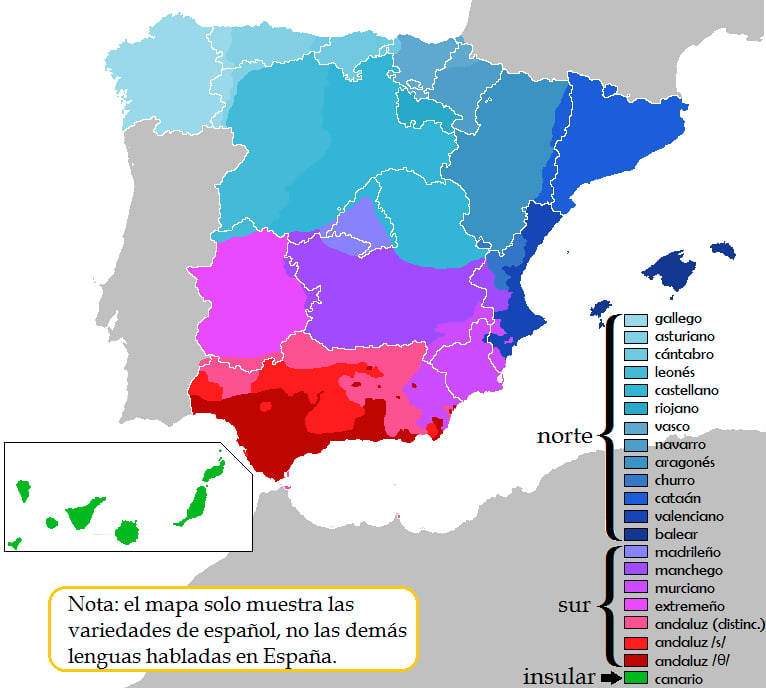If you’ve travelled or lived in different parts of Spain, you will have noticed that the way people speak Spanish can vary enormously, and the more fine-tuned your ear is, the easier it is to pick up on each accent’s idiosyncrasies.
For example, the way a person from Madrid speaks compared to someone from Andalusia is chalk and cheese.
In general terms, Spanish accents (those from the Spanish territory, not Latin America) can be divided into two categories: northern (septentrional) and southern (meridional).
There’s a similar north-south accent divide in the United Kingdom, France and Italy for example, as well as supposed ‘better’ and ‘worse’ ones.
In Spain’s case, northern accents are generally considered more neutral or ‘correct’, whereas southern ones are more often discriminated against (as always the wealthier half gets to proclaim their version as the best).
It’s all about the S
Perhaps the clearest difference between Spanish spoken in the north and south is the seseo.
Whereas in some areas of the southern half of mainland Spain and the Canary islands as a general rule people pronounce the ‘s’, ‘c’ and ‘z’ all with an ‘s’ sound, in the northern half they say ‘z’ and ‘c’ with a ‘th’ sound similar to that of English and the ‘s’ with an ‘s’ sound.
So whereas someone from Zaragoza will pronounce zapato (shoe) like ‘thapato’, in Tenerife locals will say ‘sapato’.
This of course refers to the supposed lisp that foreigners claim many Spaniards have, which isn’t true as this pronunciation distinction between ‘th’ and ‘s’ is part of the language, not a speech impediment.
There are however areas in Andalusia (Huelva, Cádiz, Granada and Almería) where locals will pronounce the ‘s’, ‘c’ and ‘z’ all as an English-style ‘th’, which is referred to as ceceo, not seseo.
Admittedly, this can come across as a lisp, but again we must stress that it’s not a speech defect (nor is the rumour true that Spaniards started using the ‘th’ sound because there was once a king with a lisp).
Another easy way to tell northern and southern Spanish accents apart is that in places such as Murcia, the Canaries and Andalusia people tend to drop the ‘s’ off the end of words, whereas anywhere north of Ciudad Real they will clearly pronounce it.
So in Santander they’ll say pasos (steps) but in Granada they’ll pronounce it ‘pasoh’.
The most recognisable Spanish accents
This is of course subjective as some keen listeners may be able to tell every Spanish accent apart, but generally speaking the most recognisable acentos are as follows:
Galician: The most identifiable trait of the Galician accent is its rhythm, in that it goes up and down, a bit like Italian. It’s also heavily influenced by the Galician language (which is similar to Portuguese) so you can expect them to throw plenty of Gallego words into the mix as well.
Catalan: The Catalan accent in Spanish is again heavily influenced by the Catalan language itself, with more guttural sounds with the ‘l’ or ‘r’ sounds creeping in.
Andalusian: Andalusia is by far the most diverse region of Spain in terms of accents, even though some common traits are often shared. For starters, they may shorten words by either dropping the consonants from the start of words (‘aro’ instead of claro, ‘of course’ in English), omit consonants from the end (‘andalú’ instead of andalúz, ‘Andalusian’ in English) and sometimes join words together (mi hija – ‘my daughter’ in English – becomes ‘mija’ in Andalusian). Again, the way someone from Cádiz speaks is very different to how a Sevillano talks (remember the ceceo and seseo mentioned earlier) but the arte (flair) and shortening of words which all Andalusians have makes it the easiest accent to recognise.
Murcian: The Murciano accent gets a bad rap in Spain for being the hardest to understand for all other Spaniards. It’s not too dissimilar to Andalusian in that it shortens words by eating up consonants, sometimes whole chunks of words (‘acho’, the most identifiable Murcian word, is actually muchacho, lad in English). Lots of slang, local expressions and slurring make it harder still for foreign Spanish speakers to understand.
Madrid: The accent of the Spanish capital is seen as rather harsh and arrogant by other Spaniards, especially those from the south, due to its strong pronunciation of consonants and the tendency to replace the ‘s’ in the middle of words with a ‘j’ (English h sound), such as ‘ej que’ rather than es que (‘it’s just that’’ in English) as well the replacement of ‘d’ with a ‘z ‘(th) sound, such as saying ‘Madriz’ rather than Madrid. Then again, it’s a very clear accent to understand for all Spaniards.
Canary: People often confuse the canario accent with that of Cuba, Puerto Rico or Venezuela, and that is no surprise as it was Canary immigrants in the 19th century that greatly influenced the Spanish spoken in that part of Latin America. The Canary accent has full seseo (‘z’, ‘c’ and ‘s’ are all pronounced like an ‘s’) and rather than dropping the ‘s’ from words like in Andalusia, they aspirate them. Other non-accent related traits of Canary speech are that they only use the past simple and not the present perfect, they say the formal ustedes (plural you in English) and not vosotros, and they use lots of shortened diminutives (pueblito instead of pueblecito, little village).
Are there other accents in Spain? Of course! Or ‘aro’ (claro) as an Andalusian would say.
Some people can recognise a Basque accent, those from Extremadura often get confused for Andalusians, the Balearic accent is similar to the Catalan one, and people from Aragón also have their unique accent traits.
The following map of Spain groups Spanish accents, with the colour scheme helping to explain which ones are similar and which are unique.

If you would like to listen carefully to the differences in accents in Spain’s 50 provinces, the video below has what you need.
Which is really the ‘best’ and the ‘worst’ Spanish accent?
This is a very divisive question as you can probably imagine.
The city of Valladolid in Castilla y León, roughly 200 kilometres northwest of Madrid, has long been regarded as being the place where the best Spanish is spoken.
As we mentioned earlier, Murcia is often considered to be the region in Spain which has the hardest to understand accent.
READ MORE: The cities in Spain where the ‘worst’ Spanish is spoken
The truth is that there is no better or worse Spanish accent, but generally speaking, the northern half of Spain can claim to have the more phonetically accurate Spanish because they don’t have the tendency to shorten words and they make a distinction between the ‘s’, the ‘c’ and the ‘z’.
However, global Spanish speakers who use seseo (s, c and z all pronounced as s) far outnumber those who don’t, as 500 million people across Latin America can assert.
Linguistic or accent discrimination, officially known as glottophobia, does exist in Spain, unfortunately. Hard-left party Unidas Podemos even tried to pass a bylaw in early 2023 which would raise awareness over accent xenophobia in society and the workplace.
You’ll struggle to find a newsreader on national TV that has an Andalusian accent for example, or a voice over artist that dubs Hollywood movies from English into Canary Spanish.
Regarding work matters, if you hold an important position and you’re from the south, you may feel you have to adopt a more standard ‘BBC’ Spanish.
Southern accents are considered low-class, uneducated and unprofessional, although in some cases this can apply to all marked regional accents.
On the flipside, a 2012 survey found that Spaniards’ favourite accents were first the Canary accent followed by the Andalusian.
People like how they sound and find them entertaining, but they won’t necessarily take them seriously.
Spain’s accent diversity is a vivid example of the cultural richness of the country and its people, and embracing and even picking up a regional accent as a foreigner should be celebrated, regardless of which accent it is.
READ ALSO: The good, the bad and the ugly – What are Spain’s regional stereotypes?



 Please whitelist us to continue reading.
Please whitelist us to continue reading.
Member comments